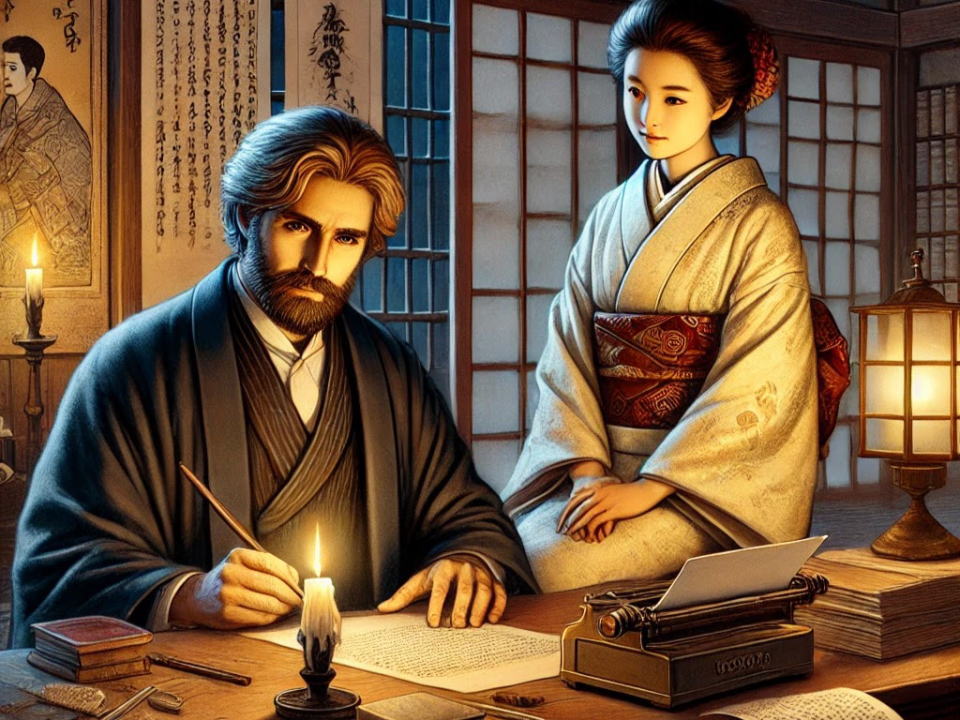
Lafcadio Hearn, known as Koizumi Yakumo in Japan, was a writer captivated by Japanese culture.
He introduced the world to Japan’s folklore and ghost stories, but behind his literary success stood a crucial figure—his wife, Koizumi Setsu.
Setsu was not just a companion; she was Hearn’s guide to Japanese culture, values, and traditions.
Her role was instrumental in shaping his understanding of Japan and influencing his literary works.
How Hearn Gained a Deep Understanding of Japanese Culture
Born in Greece, raised in Ireland and France, and later working as a journalist in the United States, Hearn was a cosmopolitan figure.
However, it was in Japan that he found his true home.
Hearn did not speak Japanese fluently, making Setsu an indispensable interpreter and cultural mentor.
She introduced him to Japan’s traditional tales, ghost stories, and folklore, many of which found their way into his writings.
Notably, Kwaidan: Stories and Studies of Strange Things contains several stories that originated from Setsu’s narrations.
The Direct Influence of Setsu on Hearn’s Works

1. Japanese Folklore in Kwaidan
Hearn’s masterpiece Kwaidan features numerous traditional Japanese ghost stories and legends.
Famous tales like "Mimi-nashi Hoichi" (Hoichi the Earless) and "Yuki-onna" (The Snow Woman) are based on folklore that Setsu shared with him.
Having grown up with these tales passed down through generations, Setsu played a key role in preserving and transmitting them to Hearn.
He, in turn, adapted them into literary works that introduced Japanese ghost stories to Western audiences.
2. Insights into Japanese Life and Customs
Through daily life with Setsu, Hearn gained firsthand experience of Japan’s seasons, customs, religious rituals, and everyday traditions.
His essays vividly describe Japanese homes, gardens, festivals, and food culture—insights that would have been impossible without Setsu’s guidance.
3. Understanding the Japanese Spirit
Hearn was deeply moved by Japanese philosophical concepts, such as mujōkan (the impermanence of things) and a deep reverence for nature.
Many of his works explore themes of life, death, and the soul’s journey.
Setsu helped him grasp these spiritual ideas by explaining Buddhist beliefs, ancestor worship, and the Japanese way of viewing the world.
These themes became central to Hearn’s literary exploration of Japan.
Setsu’s Support in Hearn’s Creative Process
Hearn was not physically strong and often suffered from illness.
During these times, Setsu took care of household matters and supported his writing.
Moreover, when Hearn needed to research Japanese folklore, Setsu actively assisted by gathering stories from local people.
In this sense, many of Hearn’s literary works were the result of their shared efforts.
Conclusion
Lafcadio Hearn’s contributions to literature were not solely his own; his wife, Setsu, played a vital role in shaping his understanding and interpretation of Japan.
She was his cultural guide, his unwavering support, and a storyteller who provided the foundation for many of his most famous works.
Hearn’s writings, which introduced Japan to the world, were in many ways a product of their deep bond and collaboration.
Their relationship was not just a marriage but a remarkable example of cross-cultural exchange that continues to resonate today.
References
https://www.hearn-museum-matsue.jp/ (Koizumi Yakumo Memorial Museum)
https://www.kankou-matsue.jp/ (Matsue City Official Tourism Site)
https://www.jnto.go.jp/ (Government of Japan Tourism Website)
